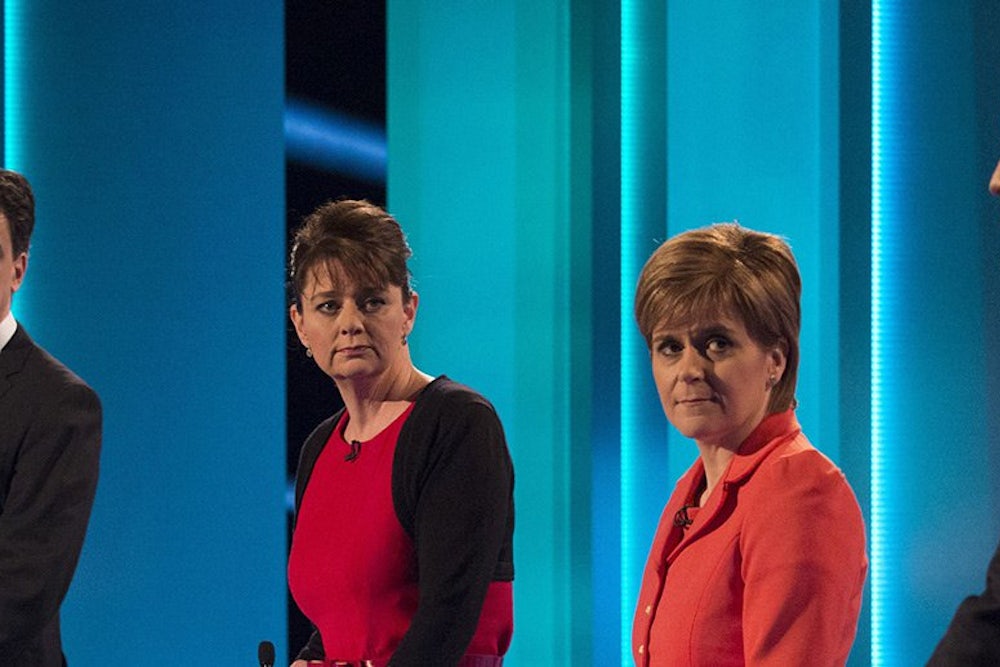Americans, frustrated with the partisan machinations of Republicans and Democrats, frequently yearn for a third party—or parties—to balance and moderate the two major ones.
On Thursday the United Kingdom will go to the polls, and all signs point to no single party winning a majority. That is, the result will be the sort of multiparty system that many American desire.
Far from moderating politics, the result has potential to make for more extreme politics and political instability.
Britain once had a stable two-party system, similar to that of the Republican/Democrat parties of the United States. In the 1950s, the Conservative and Labor parties together pulled about 96 percent of the votes and almost all of the seats in the House of Commons. The winning party would thus form a government with their leader as prime minister.
The erosion of a two-part system
Over decades, that dominance has eroded such that by the 2010 general election the two main parties only polled a total of 65 percent, meaning the major parties did not have enough seats in the House of Commons to form a government. This led to a coalition government between Conservatives and the smaller center-left Liberal Democrats, united in a common interest to get the budget deficit under control.
Current projections predict that Conservatives and Labor look to gain about two-thirds of the votes this time. Neither is likely to come close to a majority.
Where have their voters gone? Labor is mainly bleeding seats to a resurgent Scottish Nationalist Party (SNP). As its name implies, the SNP advocates Scottish independence. Ironically, being on the losing side on a referendum on the issue last September has energized a party that previously only won a handful of seats to the Parliament in London, as the party had positioned itself to the left of the Labor Party.
The SNP will likely take the majority of Scotland’s 59 seats; some projections even have the taking them all. That’s a major shift; for decades, Scotland reliably produced dozens of Labor MPs with solid majorities, akin to the typical Democratic wipeout in Massachusetts.
The machinations and maneuvering needed to create a coalition
Prime Minister David Cameron’s Conservatives face problems on two fronts. For one, their coalition partners, the Liberal Democrats, have paid the political price for the austerity policies of the past five years. Their support has slipped into single digits and the party is expected to lose half of its current 57 seats.
The Conservatives are also being pressured from the right-wing U.K. Independence Party (UKIP), whose core mission is to make Britain independent of the European Union. UKIP’s leader, Nigel Farage, with his “bloke with a pint” image and populist, anti-immigrant message, appeals to many disgruntled Conservative voters who think the current government is too moderate.
Although polling nearly 15 percent of likely voters, the vagaries of the electoral system means that the UKIP may only win a handful of seats. But the party may pull off enough Conservative voters in other constituencies to hand those seats Labor.
What might all this mean on election day? Needing 325 seats in the House of Commons to have a majority and form a government, Labor and the Conservatives are predicted to gain only somewhere between 270 to 290 seats each, depending on swings either way.
A Labor-SNP coalition seems the most likely outcome as their combined seats may create a majority.
The role of the Scottish independence party in being a deal maker
Labor leader Ed Miliband and potential prime minister, however, has categorically rejected this option during the campaign. The SNP, after all, is dedicated to breaking up the United Kingdom. Even if that issue is fudged in the short term (and expect many campaign promises to fall in the sake of coalition building), the SNP is demanding the elimination of Britain’s Trident submarine-based nuclear deterrent, currently stationed in Scotland, as part of any coalition deal. The SNP may be able to work out what is called a “confidence and supply” agreement with Labor, which would have the SNP supporting, but not formally aligning, with the government.
This arrangement would require negotiation on each individual piece of legislation. It would be difficult for a Labor government to govern effectively under such an arrangement, potentially leading to policy gridlock or governmental instability.
The Conservatives, in theory, could patch together a coalition with the LibDems, UKIP, and perhaps even the small Ulster Unionist Party. However, even with the support of these parties, Conservatives might not get a majority. Even if a coalition does emerge, relying on UKIP to govern may come at a high price, pushing the Conservatives toward an even harder line in regards to the European Union, perhaps even exiting this governing body.
In short, the rise of smaller parties, far from moderating the positions of the main parties, may push them to more extreme policies—such as abandoning Britain’s nuclear deterrent or leaving the EU.
Moreover, no matter what the specifics of the arrangement, there is potential that the next British government may be hamstrung from the start due to promises made in the scramble to build a coalition and a weak and unstable majority.
Before wishing multiparty governance on the United States, we should all take a good, hard look at how this could play out in Britain first. The results may not be so pretty.
![]()
This article was originally published on The Conversation. Read the original article.
